Quayside energy system analysis
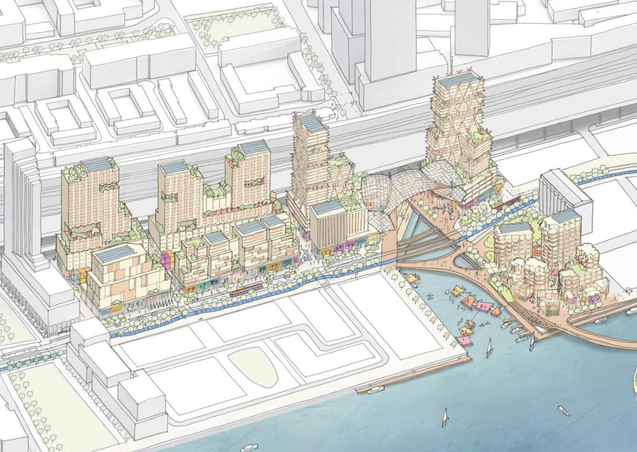
Waterfront Toronto and Alphabet’s Sidewalk Labs planned to create a new kind of mixed-use community on Toronto’s Eastern Waterfront, beginning with the creation of the Quayside area. The team’s goal was to create a flexible and expandable development that could grow to support new neighborhoods beyond the initial project. A design goal for the Quayside development was to be climate positive. Heating and cooling would be provided through a district heating and cooling (DHC) system that integrates waste heat utilization, geothermal storage and heat pumps for heating, cooling and waste heat utilization. The development stopped in May 2020 due to the impact of COVID-19 pandemic. As part of the planning, energy simulations of the buildings and of the DHC system had been conducted using input from the design team [1]. The study was concerned with the performance of the DHC system, taking as input hourly load profiles from building load simulations, and specifications for the DHC distribution provided by the design team. The objective was to understand the suitability of different design alternatives for the DHC distribution system through analysis of their energy and greenhouse gas performance, hydraulic behavior and control stability. To conduct the analysis, dynamic, annual simulations of the DHC system, of the geothermal fields and of the substations have been conducted (Figure 1). The system model was composed using component models, such as for heat pumps, geothermal fields, circulation pumps, valves, pipes and storage tanks and control blocks from the Modelica Buildings Library [2]. The study investigated three different architectures (Figure 2-3-4), including the bi-directional system [3], the uni-directional system with parallel connections, and the uni-directional system with series connections [4]. The impact of the following parameter changes was analyzed.
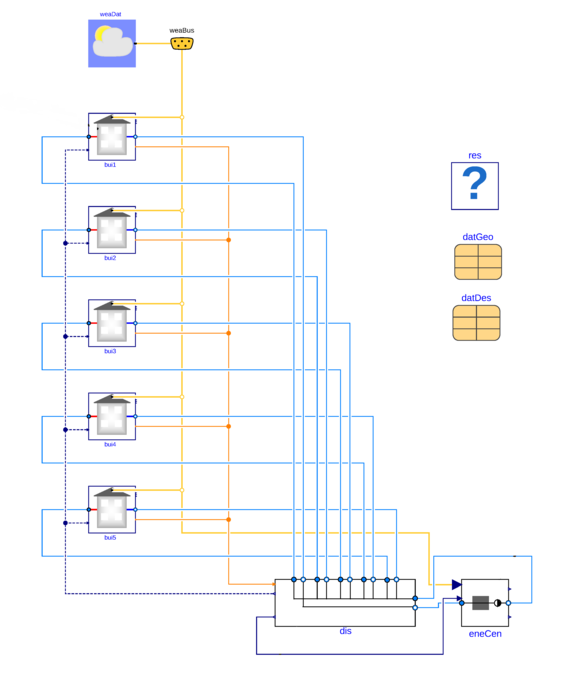
Fig.1 - Modelica simulation model
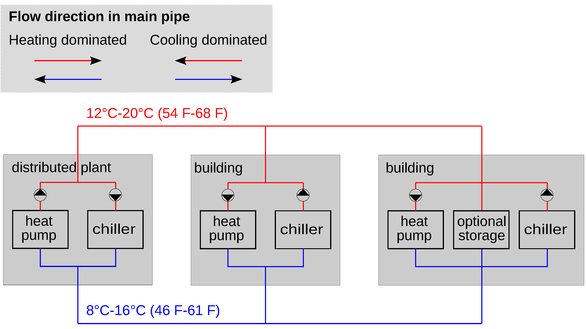
Fig.2 - Bi-directional system
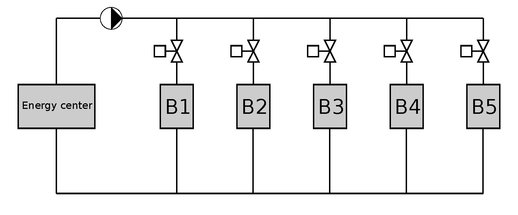
Fig.3 - Uni-directional system with parallel connection
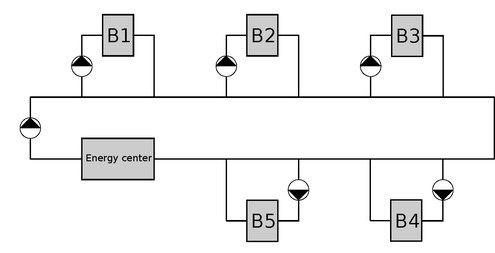
Fig.4 - Uni-directional system with series connection
The main findings were as following:
A more detailed report is available in [1].
- Use of a series or parallel uni-directional district system.
- Change in design heating water temperatures at the loads from 41/30°C to 30/25°C.
- Change in design cooling water temperatures at the loads from 4...15°C (reset based on outdoor humidity) to 10...18°C (with same reset strategy).
- Change in design heat exchanger effectiveness from 71% to 90%.
- Change in the length of the geothermal fields to 80% or 50% of their original lengths, respectively. For this change, the distance between boreholes was kept constant, thereby reducing the number of boreholes.
- Change in the distance between the boreholes to 1.12 or 1.41 of its original distance, respectively. For this change, the areas of the geothermal fields were kept constant, thereby again reducing the number of boreholes to the same number as in the above case.




The main findings were as following:
- The simulations showed that the bi-directional system experiences pressure fluctuations that makes control difficult and thereby risks that heat pumps will have low or high pressure errors. This conforms earlier observations of such problems in installed systems [5].
- The uni-directional system with series connection has better hydraulic stability and requires simpler control than the conventional uni-directional system with parallel connection. Moreover, this arrangement can be modularly expanded and connected to higher temperature loads [4].
- The uni-directional system with series connection lead to 1.4% less annual energy use and 1.3% less annual GHG emissions compared to the parallel configuration.
- By raising the design water temperature for space cooling from 4°C to 10°C and reducing the space heating temperature from 41°C to 30°C, the energy savings are 20.7%.
- Reducing the design number of boreholes, either by reducing the overall borefield area by 20% or by increasing the spacing between the drillings by a factor of 1.12, increases energy consumption by 3.4%. Thus, optimizing the number of boreholes could be an effective measure to reduce costs.
A more detailed report is available in [1].
Factsheet
| Number of buildings | 5 |
| Number of thermal zones (per building) | N/A (time series as input) |
| Complexity of thermal zone model | N/A |
| Coupling/Decoupling between district network and buildings | Decoupling |
| Simulation tool | Dymola |
| Modelica libraries | Buildings |
| Additional packages/workflows/scripts | BuildingsPy |
| Simulation time | One year |
| Computational time | 2-3 hours |
| Solver and tolerance | Cvode / 1e-6 |
| CPU speed | 2.8 GHz |
Authors:
Michael Wetter (Lawrence Berkeley National Laboratory - USA)
Jianjun Hu (Lawrence Berkeley National Laboratory - USA)
Michael Wetter (Lawrence Berkeley National Laboratory - USA)
Jianjun Hu (Lawrence Berkeley National Laboratory - USA)
References:
[1] M. Wetter, J. Hu., "Quayside energy system analysis", LBNL TR 2001197, 2019.
[2] M. Wetter, W. Zuo, T. S. Nouidui and X. Pang. "Modelica Buildings library". Journal of Building Performance Simulation, 7(4):253-270, 2014.
[3] F. Bünning, M. Wetter, M. Fuchs, and D. Müller. “Bidirectional low temperature district energy systems with agent-based control: performance comparison and operation optimization”. Applied Energy, 209:502–515, 2018.
[4] M. Sulzer, A. Sotnikov, and T. Sommer. “Reservoir-Niedertemperatur Netztopologie für die Vermaschung von thermischen Netzen”. In Status-Seminar Forschen für den Bau im Kontext von Energie und Umwelt. Zürich, Switzerland, September 2018. ETH Zürich.
[5] T. Sommer, M. Sulzer, M. Wetter, A. Sotnikov, S. Mennel and C. Stettler. “The reservoir network: A new network topology for district heating and cooling”. Energy, 199, 2020.
[1] M. Wetter, J. Hu., "Quayside energy system analysis", LBNL TR 2001197, 2019.
[2] M. Wetter, W. Zuo, T. S. Nouidui and X. Pang. "Modelica Buildings library". Journal of Building Performance Simulation, 7(4):253-270, 2014.
[3] F. Bünning, M. Wetter, M. Fuchs, and D. Müller. “Bidirectional low temperature district energy systems with agent-based control: performance comparison and operation optimization”. Applied Energy, 209:502–515, 2018.
[4] M. Sulzer, A. Sotnikov, and T. Sommer. “Reservoir-Niedertemperatur Netztopologie für die Vermaschung von thermischen Netzen”. In Status-Seminar Forschen für den Bau im Kontext von Energie und Umwelt. Zürich, Switzerland, September 2018. ETH Zürich.
[5] T. Sommer, M. Sulzer, M. Wetter, A. Sotnikov, S. Mennel and C. Stettler. “The reservoir network: A new network topology for district heating and cooling”. Energy, 199, 2020.
